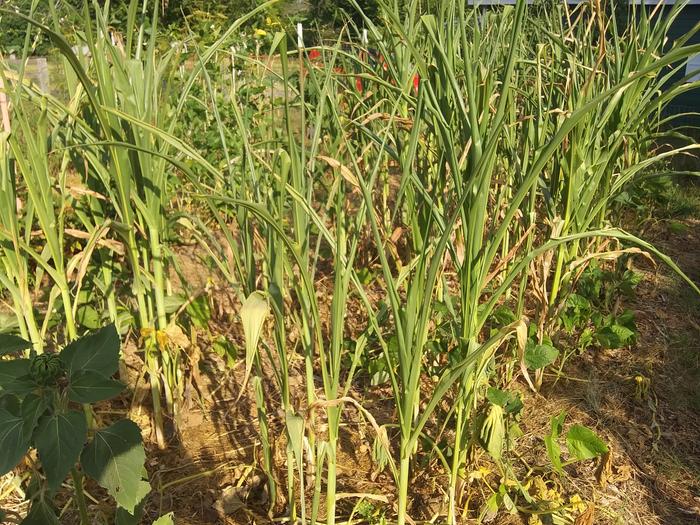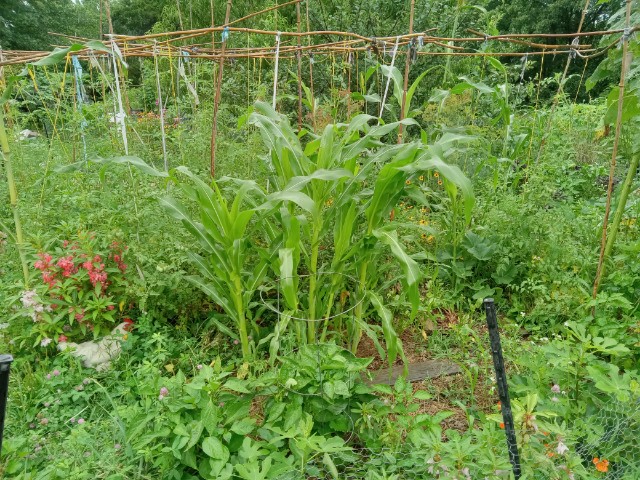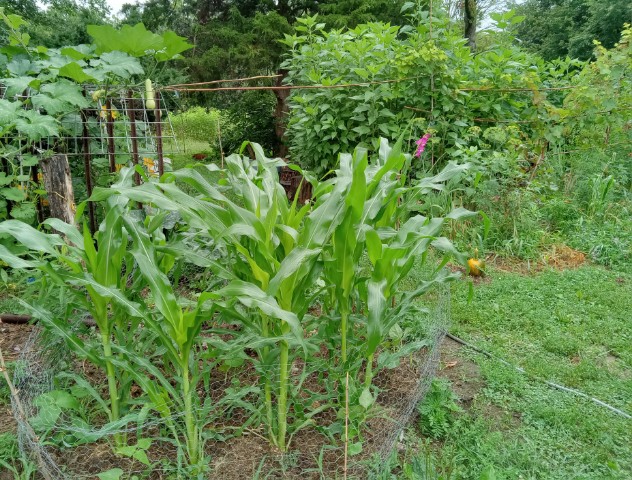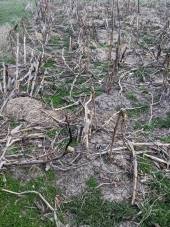

 12
12




Working toward a permaculture-strong retirement near sunny Sperling.
 6
6




 9
9




Derek Thille wrote:We tried for the first time last year, but we went from a cool spring to hot and dry, so what did germinate didn't last long. We will try again, although this year got away from me so I didn't get prepped in time.
If I showed you a photo of a corn plot in February, all you'd see is white...aside from the plants left standing.
I've looked, but didn't previously get a good grasp of when to plant things - thanks for the order - plant beans when corn has sprouted, then plant squash when beans have sprouted. We have a short enough season that I tend to do squash as starts though. I have a source for heirloom seeds that is fairly local and I like that they have some corn and squash that were grown in the region decades ago, and some varieties are what the First Nations of the plains grew.
I remember seeing a YouTube video of a gardener absolutely dissing the three sisters concept. The funny part is that he grew sweet corn, snap beans and summer squash, so he wanted to keep going into his garden to harvest and wound up damaging plants. The three sisters makes more sense when we think of it as storage crops. It also makes a lot of sense from an indigenous wisdom perspective that without refrigeration, you need crops that can be stored through the winter.
Thanks for sharing this thread. It is inspirational to see what you are doing and experimenting with. Hopefully I'll remember enough (or manage to come back early next year) to get my plans straight so I can try again.
Seeing your purple corn reminds me of a display I saw when we visited Peru. Corn (maize) may have originated in Mexico, but the Inca in Peru took it to the next level from a breeding perspective. They used purple corn to create purple dye for (mostly alpaca) wool.
 8
8




Marco Zolow wrote:I don't have space to grow as much as I would like, so I use the space I have very efficiently. I am squeezing 12 corn, 12 long bean, and 12 squash in a 5x7 area. Lots of good compost on the bed last fall, so there is good nutrition. Still feed with liquid fish fertilizers and fermented nettles and comfrey. I will have to hand pollinate, which I always have to do to get any corn. I hope this is a good year. The last two years were on less evolved soil and I had mini corn. So far I am harvesting three varieties of summer squash and there is on Kabocha on the vine. The long beans are flowering and I can see little beans starting. The corn is flowering. So far, so good.
 6
6




 6
6




 7
7




 4
4





"We're all just walking each other home." -Ram Dass
"Be a lamp, or a lifeboat, or a ladder."-Rumi
"It's all one song!" -Neil Young
 5
5




Judith Browning wrote:As our corn dried up it exposed the few southern peas surviving and somebsweet potato vines. I decided to plant more sweets since they had made it that far and watered each transplant once.
THEN...we got 3.5" of rain this week and the corn has rehydrated and competely shaded the sweet potatoes and beans.
The squash is long gone to squash bugs.
I'm adding a pic of the dry corn stalks for contrast...I did not know corn did this...will it still tassel?
 5
5




It should still tassel.
I am also fighting squash bugs. Lots of them this year. Rubbing off the eggs, and squashing the adults.
"We're all just walking each other home." -Ram Dass
"Be a lamp, or a lifeboat, or a ladder."-Rumi
"It's all one song!" -Neil Young
 3
3




Do, there is no try --- Yoda
No one is interested in something you didn't do--- Gord Downie
 5
5




Thom Bri wrote:
That's beautiful!
Surprised you have to hand-pollinate.
 3
3




Jeff Marchand wrote:I have a nice big area I want to expand my garden into and will make mounds this fall in prep for the spring . I really like that idea it front loads work from when I am overwhelmed in the garden to a time where there is nt much going on.
 5
5






Zone 6, 45 inches precipitation, hard clay soil




 2
2




May Lotito wrote:I found the seed packet and the variety I am growing is heirloom 8-row golden bantam 75 day sweet corn. Since I planted corns in mid June, the grow degree unit has been steadily accumulating at 25-30 units/day, thanks to a mild and wet summer. It certainly makes the corns grow like a clock and I am expecting tasseling in 10 days or so.
Here are what they look now in my very chaotic polyculture garden.
 5
5




 5
5




 4
4




 4
4




 3
3




Zone 6, 45 inches precipitation, hard clay soil




 4
4




May Lotito wrote:I just read about seed companies are breeding shorter corns to withstand windstorm better.
https://www.startribune.com/short-stature-corn-big-change-farming/600380475/
 6
6




Creating edible biodiversity and embracing everlasting abundance.
 3
3




Hugo Morvan wrote:Great series! I failed a couple years back. I'm more into landracing now. Hoping to get some super vigorous beans that will climb the stalks in my not supersunny climate.
Somebody on Permies had bred squashbug resistant squash over an x years period. That would be interesting to add to these gardens of yours.
 5
5




"We're all just walking each other home." -Ram Dass
"Be a lamp, or a lifeboat, or a ladder."-Rumi
"It's all one song!" -Neil Young
 3
3




Creating edible biodiversity and embracing everlasting abundance.
 3
3




Zone 6, 45 inches precipitation, hard clay soil




 1
1




Hugo Morvan wrote:Aiai, that would upset me GMO in my corn. This is the thread.
https://permies.com/t/57948/thought-permaculture-insect-control-failed
 1
1




May Lotito wrote:I am interested in growing dark color corns for craft projects so I ordered Martian Jewels and mountain morado from bakercreek today. Martian Jewels DTM is 80 -90 days butI can't find info on mountain morado. It could be 90-110 days. I am going to grow some this year, hopefully I will beat the first frost to get some harvest. If the two DTMs are 20 days apart, will they still cross pollinate?
 2
2




Do, there is no try --- Yoda
No one is interested in something you didn't do--- Gord Downie
 4
4




Jeff Marchand wrote:I dont know if its been said but squash take up alot of space in the garden, if you are not going do a 3 sisters garden where are you planting your squashes and pumpkins? I did nt a 3 sisters garden this year and mistake #1 was planting my squashes by my leeks and onions. They are shading out the aliums. Garlic would have made a better choice as they would be out of the garden by now. Mistake #2 was to plant pumpkins off on their own with plenty of space which then filled with weeds that I have to clean out with not much payback for the effort.
 4
4





 3
3




Zone 6, 45 inches precipitation, hard clay soil




 4
4




May Lotito wrote:Sorry to hear your corns got hit by winds again. Hopefully the lodged ones will recover. How about the snapped ones? Will the ears continue to develop?
The comparison to the corn field in the background is intriguing. I am wondering if the root lodging has to do with planting in the hills. If the hill is high in organic matters, are you still able to plant seeds 2 inches deep in mineral soil? Or they are actually growing above ground level? If so, over the growing season as the organic matters decompose, the roots will have less contact with the media to hold strongly. Also, more nutritious soil makes your corns taller and more susceptible to high winds than those in the regular farm.
 3
3




 2
2




 7
7




Zone 6, 45 inches precipitation, hard clay soil




 4
4




May Lotito wrote:I am testing if I can convert a piece of lawn quickly for growing corn and restore it after the corns are harvested.
I wanted to grow more corns but it was kind of late for the season, besides, I didn't have any garden space available. I decided to solarize an area in the middle of my back yard and use it for growing. At the same time, I bagged up grass clippings to make hot compost for nitrogen rich fertilizer since corn are heavy feeders. Here is the progress so far:
 7
7




 6
6




A friend was recently reading a book and it suggested that this was the traditional use of the 3-sister's garden. It's too chaotic to be going in to harvest on a daily or weekly basis which I do if I'm harvesting green beans. If I want dried beans, they get left alone until fall.William Bronson wrote: We think of the three as long season plants left to produce storage crops.
Visit Redhawk's soil series: https://permies.com/wiki/redhawk-soil
How permies.com works: https://permies.com/wiki/34193/permies-works-links-threads
 4
4




Jay Angler wrote:
I am not convinced this is a system that would have been used in my ecosystem, and the few times I've tried, the plants struggled probably due to our cool nights and summer droughts.
But I admire all the awesome permies that are making this work and learning in the meantime.
Remember that field fertility or lack there of, wouldn't have been the only reason for Indigenous people to have moved on to new ground. They may have hunted out an area, used all the easy firewood, or created too much of a poop pile. There are many good reasons for short-term settlement and many benefits of a semi-nomadic lifestyle particularly in some ecosystems.

|
look out! This tiny ad has a whip!
The new gardening playing cards kickstarter is now live!
https://www.kickstarter.com/projects/paulwheaton/garden-cards
|









